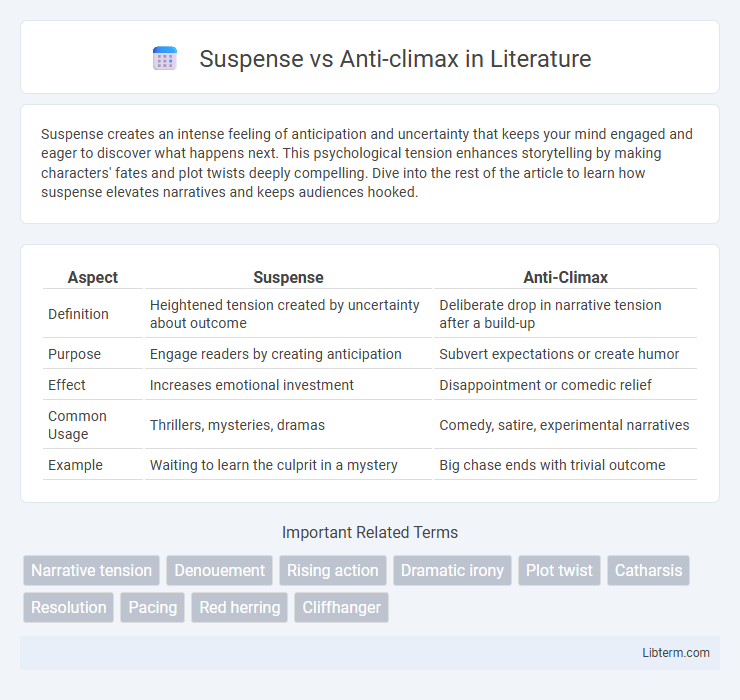Suspense creates an intense feeling of anticipation and uncertainty that keeps your mind engaged and eager to discover what happens next. This psychological tension enhances storytelling by making characters' fates and plot twists deeply compelling. Dive into the rest of the article to learn how suspense elevates narratives and keeps audiences hooked.
Table of Comparison
| Aspect | Suspense | Anti-Climax |
|---|---|---|
| Definition | Heightened tension created by uncertainty about outcome | Deliberate drop in narrative tension after a build-up |
| Purpose | Engage readers by creating anticipation | Subvert expectations or create humor |
| Effect | Increases emotional investment | Disappointment or comedic relief |
| Common Usage | Thrillers, mysteries, dramas | Comedy, satire, experimental narratives |
| Example | Waiting to learn the culprit in a mystery | Big chase ends with trivial outcome |
Understanding Suspense in Storytelling
Suspense in storytelling builds anticipation by creating uncertainty about outcomes, engaging the audience's emotions and curiosity. It relies on well-timed pacing, foreshadowing, and conflict escalation to keep viewers or readers invested in the narrative. Unlike an anti-climax, which results in a disappointing or trivial resolution, effective suspense maintains tension until a satisfying payoff.
Defining Anti-climax: Breaking Expectations
Anti-climax occurs when a narrative builds tension or expectation but ends in an unexpectedly trivial or disappointing way, disrupting audience anticipation. This technique deliberately breaks expectations by substituting a powerful climax with an underwhelming resolution, often to create humor or highlight absurdity. The contrast between suspenseful buildup and anticlimactic payoff emphasizes a deliberate subversion of traditional storytelling conventions.
The Role of Suspense in Engaging Readers
Suspense heightens emotional investment by creating anticipation and uncertainty, encouraging readers to continue for resolution. It strategically withholds key information, prompting curiosity and deepening narrative engagement. Unlike anti-climax, which diminishes tension by resolving conflicts abruptly or unsatisfactorily, suspense sustains interest and drives story momentum.
Anti-climax: Disappointment or Literary Tool?
Anti-climax often serves as a deliberate literary tool designed to subvert audience expectations, creating a sense of irony or humor by delivering a less dramatic or unexpected outcome. While it can lead to disappointment when readers or viewers anticipate a more intense resolution, skilled authors use anti-climax to emphasize thematic elements or highlight character flaws. This technique contrasts with suspense, which builds tension and anticipation, making anti-climax a strategic device to challenge conventional narrative arcs.
Narrative Techniques for Building Suspense
Suspense in narrative techniques is created by carefully controlling the flow of information to the audience, often through foreshadowing, pacing, and escalating stakes that keep readers emotionally invested and eager to discover the outcome. Anti-climax occurs when the built-up tension resolves in an unexpectedly trivial or disappointing way, undermining previous suspense and altering the audience's emotional response. Effective suspense relies on maintaining atmosphere, strategic use of timing, and consistent narrative tension to ensure the resolution meets audience expectations without devolving into anti-climax.
Common Pitfalls Leading to Anti-climax
Suspense relies on building tension and anticipation through strategic pacing and carefully placed clues, while anti-climax results from a sudden drop in intensity that fails to meet audience expectations. Common pitfalls leading to anti-climax include underdeveloped conflicts, predictable plot twists, and a rushed resolution that neglects character development and plot coherence. Effective suspense demands a balance of mystery, emotional investment, and well-crafted narrative peaks to avoid disappointing the audience with anti-climactic endings.
Psychological Impact: Suspense vs Anti-climax
Suspense heightens psychological engagement by triggering anticipation and emotional arousal, which activates neural pathways related to reward and anxiety, enhancing memory retention and immersive experience. In contrast, an anti-climax often induces a psychological release or deflation, leading to feelings of disappointment or relief that can diminish sustained attention and emotional investment. The contrast between sustained tension in suspense and abrupt resolution in anti-climax critically shapes audience satisfaction and cognitive processing of narratives.
Iconic Examples of Suspense in Literature and Film
Suspense builds tension and anticipation by keeping the audience uncertain about the outcome, as masterfully demonstrated in Alfred Hitchcock's film "Psycho," where the famous shower scene creates intense anxiety through pacing and sound. In literature, Daphne du Maurier's "Rebecca" creates suspense through the mysterious atmosphere and gradual revelations, maintaining readers' intrigue about the protagonist's fate. Anti-climax, by contrast, subverts expectations by delivering a deflating or unexpected resolution, often used to surprise or critique traditional narrative arcs.
Memorable Anti-climax Moments in Storytelling
Memorable anti-climax moments in storytelling subvert audience expectations by delivering an unexpected, often underwhelming resolution after building significant tension. This technique can heighten emotional impact or satire, as seen in works like "Breaking Bad," where certain plotlines deflate anticipated climaxes to emphasize realism or irony. Effective anti-climaxes contrast sharply with suspense, which maintains continuous tension and anticipation toward a peak event, making the anti-climax a powerful tool for thematic depth and memorability.
Balancing Suspense and Resolution for Narrative Impact
Balancing suspense and resolution in narrative impact requires carefully pacing the build-up of tension with timely, satisfying payoffs that avoid anti-climaxes, which can undermine audience engagement and emotional investment. Effective suspense leverages uncertainty and expectation, while resolution delivers clarity and emotional release, ensuring the story maintains momentum without frustrating readers or viewers. Strategically managing this balance enhances narrative tension and audience satisfaction, making the story compelling and memorable.
Suspense Infographic

 libterm.com
libterm.com